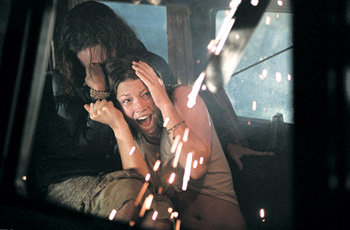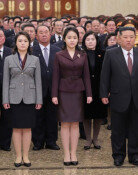The Texas Chainsaw Massacre 2003
The Texas Chainsaw Massacre 2003
Posted June. 17, 2005 03:25,

Movie remakes have the unavoidable destiny of being compared with the original. Interestingly enough, for horror remakes, the following movie review holds true in most cases: The shocking significance of the original in the movie industry was reduced, but in terms of visual effects and visual image, the remake shows them more vividly and scarily. This interpretation is truly applicable to The Texas Chainsaw Massacre 2003, the remake of the original The Texas Chainsaw Massacre, the classics of modern horror films, which was released in 1974.
The original movie was based on a true story. In the film, a murderer suddenly appears and chops others down recklessly without any plan, logic, or motive. Such irrationality and recklessness was recognized by audiences as an element that penetrates into the essence of modern society and life.
The remake, made 30 years after the original, has reduced the absurdity of the original and replaced it with more sophistication and believable scariness. Nevertheless, it is just too scary. Forget about its value as compared with the original or its significance in movie history.
In the remake, five people are on a road trip in Texas. On the way, they pick up a sinister female hitchhiker. The woman suddenly takes a gun out, puts it into her mouth and pulls the trigger. The group enters a remote village to find a police station, but rather than finding safety, the group finds its numbers dwindling. In the village, the people find a murderer named Leather Face wearing a leather face made from the skins of the victims he killed.
Texas Chainsaw Massacre 2003 achieves its goal by literally carrying out what the horrific title suggests, with the murderer chasing victims (and the audience) for 97 minutes in a remote village. In a way, it is a good horror movie in spite of the fact that the audience may become sick and tired of the annoying sounds of the chainsaw.
The female character, Erin (Jessica Biel), clad in a see-through tank top, barely survives the chainsaw. But what attracts audiences even more than her tank top is the texture of horror in the zone of Texas itself. Different from the original, where night scenes were emphasized, the remake has massacre and chase scenes that take place in broad daylight. The original movies cinematographer, Daniel Pearl, again depicts the hazy fog of the vast land of Texas. The yellowish land and the strong sunlight nicely emphasize the suspenseful and horrific characters.
The original invited some political and social interpretations. The family that nurtures a murderer was interpreted as a depiction of the collapse of family culture in the 1970s. Scenes of human being hung on hooks after being slaughtered like pigs and cows were seen as a reflection of societys departure from humanism.
Different from the recent popular Hollywood movies that are remakes of Japanese horror movies like The Grudge, and The Ring, this movie is rather unique in that it shows American-style horror. There is the murderer wielding a chainsaw, a traditional symbol of the machinery of civilization and pioneering (used to cut timber), in a wide, vast Texan land, which itself is a horror.
The movie raises the audiences tension levels to a height with the physical and corporal energy of genuine horror. It is in stark contrast to Japanese horror movies in which female ghosts hold up sharp nails in narrow closets or blankets. This American-style horror film stresses a male antagonist in a vast physical place instead.
This remake is the first movie directed by Marcus Nispel, who has directed music videos and commercial advertisements in the past. The remake will be released on June 16 and is intended for audiences ages 18 and older.
Seung-Jae Lee sjda@donga.com






![전기매트 틀고 자면 몸에 전자파 쌓인다?” 직접 측정해보니 [알쓸톡]](https://dimg.donga.com/c/138/175/90/1/wps/NEWS/IMAGE/2026/01/02/133079758.3.jpg)
